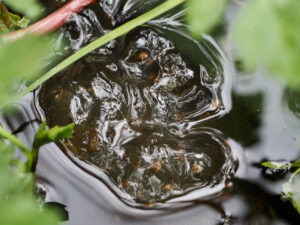We hope you’re enjoying all the daily transformations.

In this season of beauty and wonder, sometimes we come upon intriguing, even mysterious, natural phenomena. Last week, I (Wendy) was looking under plywood boards as part of the Land Trust’s “Amphibian Project,” and although no amphibians appeared yet this year, several tiny Red Alder cones had rolled under the soggy boards, many covered in minuscule, powder blue cup fungus. What species was this? Why only on these cones? I couldn’t find the answer in my field guide. Then to my surprise, mycologists on iNaturalist quickly identified it as Lachnum virgineum (Stalked Hairy Fairy Cup). One mystery solved.

I asked Dave what mysteries he ponders. He replied, “Wildlife tracks can be clear – as on a sandy beach or in the snow – or just a hint – as on forest litter. It’s often a real challenge to figure out who walked on that trail ahead of you. Taking a course on tracking is an excellent introduction to understanding what’s out there and sorting out marks, scratches, scat, and other wildlife signs.”

The April newsletter tells the story of another mystery, and how it was solved. There’s so much to observe and ponder on the Olympic Peninsula. Please let us know if you want to share any photos of any unsolved mysteries.










